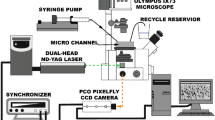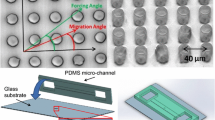Abstract
We present a computational investigation of the mechanism governing size-based particle separation in microfluidic pinched flow fractionation. We study the behavior of particles moving through a pinching gap (i.e., a constriction in the aperture of a channel) in the Stokes regime (negligible fluid and particle inertia) as a function of particle size. The constriction aperture is created by a plane wall and spherical obstacle, and emulates the pinching segment in pinched flow fractionation devices. The simulation results show that the distance of closest approach between the particle and obstacle surfaces (along a trajectory) decreases with increasing particle size. We then use the distance of closest approach to investigate the effect of short-range repulsive non-hydrodynamic interactions (e.g., solid-solid contact due to surface roughness, electrostatic, or steric repulsion, etc.). We define a critical trajectory as the one in which the minimum particle–obstacle separation is equal to the range of the non-hydrodynamic interactions. The results further show that the initial offset of the critical trajectory (defined as the critical offset) increases with particle size. We interpret the variation of the critical offset with particle size as the basis for size-based microfluidic separation in pinched flow fractionation. We also compare the effect of different driving fields on the particle trajectories; we simulate a constant force driving the particles in a quiescent fluid as well as a freely suspended particles in a pressure-driven flow. We observe that the particles approach closer to the obstacle when driven by a constant force, than those freely suspended in a pressure driven flow (for the same initial offset). On the other hand, the increment in the critical offset (as a function of particle size) is larger in the pressure-driven case than in the force-driven case. Thus, pressure-driven particle separation using pinched flow fractionation would prove more effective than its force-driven counterpart (e.g., particles settling under gravity through a pinching gap).





Similar content being viewed by others
References
Ashley JF, Bowman CN, Davis RH (2013) Hydrodynamic separation of particles using pinched-flow fractionation. AIChE J 59(9):3444–3457
Balvin M, Sohn E, Iracki T, Drazer G, Frechette J (2009) Directional locking and the role of irreversible interactions in deterministic hydrodynamics separations in microfluidic devices. Phys Rev Lett 103:078301
Bowman T, Frechette J, Drazer G (2012) Force driven separation of drops by deterministic lateral displacement. Lab Chip 12:2903–2908
Devendra R, Drazer G (2012) Force driven deterministic lateral displacement for particle separation in microfluidic devices. Anal Chem 84:10621–10627
Faivre M, Abkarian M, Bickraj K, Stone HA (2006) Geometrical focusing of cells in a microfluidic device: an approach to separate blood plasma. Biorheology 43:147–159
Frechette J, Drazer G (2009) Directional locking and deterministic separation in periodic arrays. J Fluid Mech 627:379–401
Han J, Craighead HG (2000) Separation of long DNA molecules in a microfabricated entropic trap array. Science 288(5468):1026–1029
Huang LR, Cox EC, Austin RH, Sturm JC (2004) Continuous particle separation through deterministic lateral displacement. Science 304(5673):987–990
Ladd AJC (1994a) Numerical simulations of particulate suspensions via a discretized boltzmann equation. Part 1. Theoretical foundation. J Fluid Mech 271:285–309
Ladd AJC (1994b) Numerical simulations of particulate suspensions via a discretized boltzmann equation. Part 2. Numerical results. J Fluid Mech 271:311–339
Larsen AV, Poulsen L, Birgens H, Dufva M, Kristensen A (2008) Pinched flow fractionation devices for detection of single nucleotide polymorphisms. Lab Chip 8(5):818–821
Lee KH, Kim SB, Lee KS, Sung HJ (2011) Enhancement by optical force of separation in pinched flow fractionation. Lab Chip 11(2):354–357
Luo M, Sweeney F, Risbud SR, Drazer G, Frechette J (2011) Irreversibility and pinching in deterministic particle separation. Appl Phys Lett 99(6):064102
Maenaka H, Yamada M, Yasuda M, Seki M (2008) Continuous and size-dependent sorting of emulsion droplets using hydrodynamics in pinched microchannels. Langmuir 24:4405–4410
Morijiri T, Sunahiro S, Senaha M, Yamada M, Seki M (2011) Sedimentation pinched-flow fractionation for size-and density-based particle sorting in microchannels. Microfluid Nanofluid 11(1):105–110
Mortensen NA (2007) Comment on pinched flow fractionation: continuous size separation of particles utilizing a laminar flow profile in a pinched microchannel. Anal Chem 79:9240–9241
Mustin B, Stoeber B (2010) Deposition of particles from polydisperse suspensions in microfluidic systems. Microfluid Nanofluid 9:905–913
Nguyen NQ, Ladd AJC (2002) Lubrication corrections for lattice-Boltzmann simulations of particle suspensions. Phys Rev E 66:046708
Risbud SR, Drazer G (2013) Trajectory and distribution of non-Brownian suspended particles moving past a fixed spherical or cylindrical obstacle. J Fluid Mech 714:213–237
Risbud SR, Luo M, Frechette J, Drazer G (2013) Analysis of the trajectory of a sphere moving through a geometric constriction. Phys Fluids 25:062001
Shardt O, Mitra SK, Derksen JJ (2012) Lattice boltzmann simulations of pinched flow fractionation. Chem Eng Sci 75:106–119
Vig AL, Kristensen A (2008) Separation enhancement in pinched flow fractionation. Appl Phys Lett 93:203507
Wyss HM, Blair DL, Morris JF, Stone HA, Weitz DA (2006) Mechanism for clogging of microchannels. Phys Rev E 74:061402
Xuan X, Zhu J, Church C (2010) Particle focusing in microfluidic devices. Microfluid Nanofluid 9(1):1–16
Yamada M, Nakashima M, Seki M (2004) Pinched flow fractionation: continuous size separation of particles utilizing a laminar flow profile in a pinched microchannel. Anal Chem 76(18):5465–5471
Acknowledgments
We thank Prof. A. J. C. Ladd for making the LB code, Susp3d, available to us. This work is partially supported by the National Science Foundation Grant No. CBET-1343924. This work used the resources of the National Energy Research Scientific Computing Center, which is supported by the Office of Science of the US Department of Energy under Contract No. DE-AC02-05CH11231.
Author information
Authors and Affiliations
Corresponding author
Rights and permissions
About this article
Cite this article
Risbud, S.R., Drazer, G. Mechanism governing separation in microfluidic pinched flow fractionation devices. Microfluid Nanofluid 17, 1003–1009 (2014). https://doi.org/10.1007/s10404-014-1404-0
Received:
Accepted:
Published:
Issue Date:
DOI: https://doi.org/10.1007/s10404-014-1404-0




